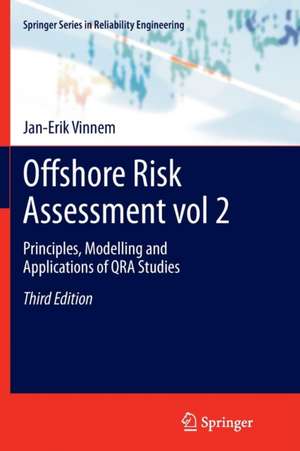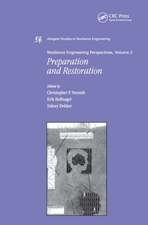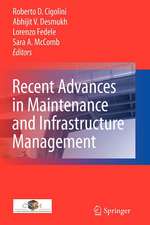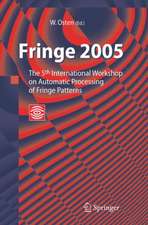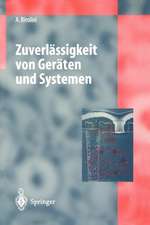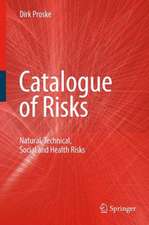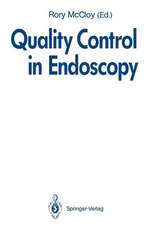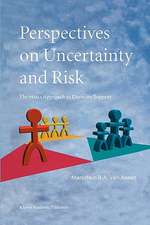Offshore Risk Assessment vol 2.: Principles, Modelling and Applications of QRA Studies: Springer Series in Reliability Engineering
Autor Jan-Erik Vinnemen Limba Engleză Paperback – 23 aug 2016
This updated and expanded third edition has been informed by a major R&D program on offshore risk assessment in Norway and summarizes research from 2006 to the present day. Rooted with a thorough discussion of risk metrics and risk analysis methodology, subsequent chapters are devoted to analytical approaches to escalation, escape, evacuation and rescue analysis of safety and emergency systems.
Separate chapters analyze the main hazards of offshore structures: fire, explosion, collision, and falling objects as well as structural and marine hazards. Risk mitigation and control are discussed, as well as an illustration of how the results from quantitative risk assessment studies should be presented. The third second edition has a stronger focus on the use of risk assessment techniques in the operation of offshore installations. Also decommissioning of installations is covered.
Not only does Offshore Risk Assessment describe the state of the art of QRA, it also identifies weaknesses and areas that need further development. This new edition also illustrates applications or quantitative risk analysis methodology to offshore petroleum applications.
A comprehensive reference for academics and students of marine/offshore risk assessment andmanagement, the book should also be owned by professionals in the industry, contractors, suppliers, consultants and regulatory authorities.
Din seria Springer Series in Reliability Engineering
- 18%
 Preț: 1406.66 lei
Preț: 1406.66 lei - 18%
 Preț: 1122.56 lei
Preț: 1122.56 lei - 20%
 Preț: 1277.89 lei
Preț: 1277.89 lei - 18%
 Preț: 952.09 lei
Preț: 952.09 lei - 24%
 Preț: 1048.70 lei
Preț: 1048.70 lei - 20%
 Preț: 940.34 lei
Preț: 940.34 lei - 20%
 Preț: 987.32 lei
Preț: 987.32 lei - 18%
 Preț: 951.29 lei
Preț: 951.29 lei - 18%
 Preț: 947.02 lei
Preț: 947.02 lei - 15%
 Preț: 651.51 lei
Preț: 651.51 lei - 15%
 Preț: 635.65 lei
Preț: 635.65 lei - 18%
 Preț: 1228.44 lei
Preț: 1228.44 lei - 18%
 Preț: 1227.67 lei
Preț: 1227.67 lei - 18%
 Preț: 952.89 lei
Preț: 952.89 lei - 18%
 Preț: 1234.94 lei
Preț: 1234.94 lei - 18%
 Preț: 952.09 lei
Preț: 952.09 lei - 18%
 Preț: 1236.19 lei
Preț: 1236.19 lei - 18%
 Preț: 1322.35 lei
Preț: 1322.35 lei - 20%
 Preț: 1274.57 lei
Preț: 1274.57 lei - 15%
 Preț: 643.34 lei
Preț: 643.34 lei - 18%
 Preț: 1109.16 lei
Preț: 1109.16 lei - 15%
 Preț: 635.65 lei
Preț: 635.65 lei - 15%
 Preț: 654.62 lei
Preț: 654.62 lei - 18%
 Preț: 944.99 lei
Preț: 944.99 lei - 18%
 Preț: 953.65 lei
Preț: 953.65 lei - 18%
 Preț: 1213.16 lei
Preț: 1213.16 lei - 18%
 Preț: 956.50 lei
Preț: 956.50 lei - 15%
 Preț: 644.95 lei
Preț: 644.95 lei - 18%
 Preț: 950.52 lei
Preț: 950.52 lei - 18%
 Preț: 1233.97 lei
Preț: 1233.97 lei - 15%
 Preț: 640.06 lei
Preț: 640.06 lei - 18%
 Preț: 956.69 lei
Preț: 956.69 lei - 18%
 Preț: 940.39 lei
Preț: 940.39 lei - 18%
 Preț: 948.92 lei
Preț: 948.92 lei -
 Preț: 389.70 lei
Preț: 389.70 lei - 18%
 Preț: 943.73 lei
Preț: 943.73 lei - 18%
 Preț: 940.57 lei
Preț: 940.57 lei - 20%
 Preț: 985.03 lei
Preț: 985.03 lei - 18%
 Preț: 943.43 lei
Preț: 943.43 lei - 18%
 Preț: 1218.21 lei
Preț: 1218.21 lei - 18%
 Preț: 948.16 lei
Preț: 948.16 lei - 18%
 Preț: 948.92 lei
Preț: 948.92 lei - 18%
 Preț: 1727.24 lei
Preț: 1727.24 lei - 15%
 Preț: 638.43 lei
Preț: 638.43 lei - 24%
 Preț: 802.76 lei
Preț: 802.76 lei
Preț: 592.12 lei
Preț vechi: 696.60 lei
-15% Nou
Puncte Express: 888
Preț estimativ în valută:
113.32€ • 117.87$ • 93.55£
113.32€ • 117.87$ • 93.55£
Carte tipărită la comandă
Livrare economică 14-28 aprilie
Preluare comenzi: 021 569.72.76
Specificații
ISBN-13: 9781447170815
ISBN-10: 1447170814
Pagini: 462
Ilustrații: XLII, 420 p. 102 illus., 15 illus. in color.
Dimensiuni: 155 x 235 x 24 mm
Greutate: 0.64 kg
Ediția:Softcover reprint of the original 3rd ed. 2014
Editura: SPRINGER LONDON
Colecția Springer
Seria Springer Series in Reliability Engineering
Locul publicării:London, United Kingdom
ISBN-10: 1447170814
Pagini: 462
Ilustrații: XLII, 420 p. 102 illus., 15 illus. in color.
Dimensiuni: 155 x 235 x 24 mm
Greutate: 0.64 kg
Ediția:Softcover reprint of the original 3rd ed. 2014
Editura: SPRINGER LONDON
Colecția Springer
Seria Springer Series in Reliability Engineering
Locul publicării:London, United Kingdom
Cuprins
Part III.- 14.Methodology for Quantified Risk Assessment.- 15.Analysis Techniques.- 16.Presentation of Risk Results from QRA Studies.- 17.Evaluation of Personnel Risk Levels.- 18.Environmental Risk Analysis.- 19.Approach to Risk Based Design.- 20.Risk based Emergency Response Planning.- Part IV.- 21.Use of Risk Analysis during the Operations Phase.- 22.Use of Risk Indicators for Major Hazard Risk.- 23.Barrier Management for Major Hazard Risk.- Appendix A.Overview of Software.- Appendix B.Overview of Fatalities in Norwegian Sector.- Appendix C.Network Resources.
Notă biografică
Jan Erik Vinnem is Professor II of Risk Analysis at University of Stavanger, Norway. He is also a specialist advisor and CEO of Preventor AS, a consultancy to the Norwegian offshore industry. His professional career includes experience in the petroleum industry (Statoil and Total), and work as a private consultant (as the founder of Safetec Nordic AS and Preventor AS), in addition to his time in research and education. His research interests include decision support tools, risk management, risk acceptance, risk analysis methods, and risk assessments reflecting human and organizational factors
Textul de pe ultima copertă
Offshore Risk Assessment was the first book to deal with quantified risk assessment (QRA) as applied specifically to offshore installations and operations. Risk assessment techniques have been used for more than three decades in the offshore oil and gas industry, and their use is set to expand increasingly as the industry moves into new areas and faces new challenges in older regions.
This updated and expanded third edition has been informed by a major R&D program on offshore risk assessment in Norway and summarizes research from 2006 to the present day. Rooted with a thorough discussion of risk metrics and risk analysis methodology, subsequent chapters are devoted to analytical approaches to escalation, escape, evacuation and rescue analysis of safety and emergency systems.
Separate chapters analyze the main hazards of offshore structures: fire, explosion, collision, and falling objects as well as structural and marine hazards. Risk mitigation and control are discussed, as well as an illustration of how the results from quantitative risk assessment studies should be presented. The third second edition has a stronger focus on the use of risk assessment techniques in the operation of offshore installations. Also decommissioning of installations is covered.
Not only does Offshore Risk Assessment describe the state of the art of QRA, it also identifies weaknesses and areas that need further development. This new edition also illustrates applications or quantitative risk analysis methodology to offshore petroleum applications.
A comprehensive reference for academics and students of marine/offshore risk assessment andmanagement, the book should also be owned by professionals in the industry, contractors, suppliers, consultants and regulatory authorities.
This updated and expanded third edition has been informed by a major R&D program on offshore risk assessment in Norway and summarizes research from 2006 to the present day. Rooted with a thorough discussion of risk metrics and risk analysis methodology, subsequent chapters are devoted to analytical approaches to escalation, escape, evacuation and rescue analysis of safety and emergency systems.
Separate chapters analyze the main hazards of offshore structures: fire, explosion, collision, and falling objects as well as structural and marine hazards. Risk mitigation and control are discussed, as well as an illustration of how the results from quantitative risk assessment studies should be presented. The third second edition has a stronger focus on the use of risk assessment techniques in the operation of offshore installations. Also decommissioning of installations is covered.
Not only does Offshore Risk Assessment describe the state of the art of QRA, it also identifies weaknesses and areas that need further development. This new edition also illustrates applications or quantitative risk analysis methodology to offshore petroleum applications.
A comprehensive reference for academics and students of marine/offshore risk assessment andmanagement, the book should also be owned by professionals in the industry, contractors, suppliers, consultants and regulatory authorities.
Caracteristici
Gives a detailed overview of all aspects of QRA is useful for graduate students, researchers, consultants, and authorities Expands on the practical applications or quantitative risk analysis methodology to offshore petroleum applications from the second edition with new research Includes new chapters to cover the specific case studies of the US Macondo incident of 2010
